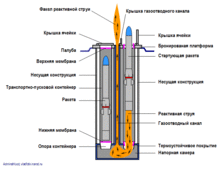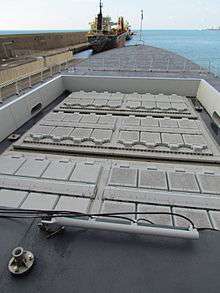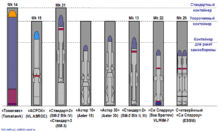Vertical launching system
_aboard_the_guided_missile_cruiser_USS_San_Jacinto_(CG_56).jpg)
_stabilize_a_crate_containing_a_Tomahawk_cruise_missile.jpg)
A vertical launching system (VLS) is an advanced system for holding and firing missiles on mobile naval platforms, such as surface ships and submarines. Each vertical launch system consists of a number of cells, which can hold one or more missiles ready for firing. Typically, each cell can hold a number of different types of missiles, allowing the ship flexibility to load the best set for any given mission. Further, when new missiles are developed, they are typically fitted to the existing vertical launch systems of that nation, allowing existing ships to use new types of missiles without expensive rework. When the command is given, the missile flies straight up long enough to clear the cell and the ship, and then turns on course.
A VLS allows surface combatants to have a greater number of weapons ready for firing at any given time compared to older launching systems such as the Mark 13 single-arm and Mark 26 twin-arm launchers, which were fed from behind by a magazine below the main deck. In addition to greater firepower, VLS is much more damage tolerant and reliable than the previous systems, and has a lower radar cross-section (RCS). The U.S. Navy now relies exclusively on VLS for its guided missile destroyers and cruisers.
The most widespread vertical launch system in the world is the Mark 41, developed by the US Navy. More than 11,000 Mark 41 VLS missile cells have been delivered, or are on order, for use on 186 ships across 19 ship classes, in 11 navies around the world. This system currently serves with the US Navy as well as the Australian, Canadian, Danish, Dutch, German, Japanese, New Zealand, Norwegian, South Korean, Spanish, and Turkish navies, while others like the Greek Navy preferred the similar Mark 48 system.[1]
The advanced Mark 57 vertical launch system is projected to be used on the new Zumwalt-class destroyer. The older Mark 13 and Mark 26 systems remain in service on ships that were sold to other countries such as Taiwan and Poland.
When installed on an SSN (nuclear-powered attack submarine), a VLS allows a greater number and variety of weapons to be deployed, compared with using only torpedo tubes.
Hot launch and cold launch

A vertical launch system can be either hot launch, where the missile ignites in the cell, or cold launch, where the missile is expelled by gas produced by a gas generator which is not part of the missile itself, and then the missile ignites. "Cold" means relatively cold compared with rocket engine exhaust. A hot launch system does not require an ejection mechanism, but does require some way of disposing of the missile's exhaust and heat as it leaves the cell. If the missile ignites in a cell without an ejection mechanism, the cell must withstand the tremendous heat generated without igniting the missiles in the adjacent cells.
_during_a_training_exercise.jpg)
An advantage of a hot-launch system is that the missile propels itself out of the launching cell using its own engine, which eliminates the need for a separate system to eject the missile from the launching tube. This potentially makes a hot-launch system relatively light, small, and economical to develop and produce, particularly when designed around smaller missiles. A potential disadvantage is that a malfunctioning missile could destroy the launch tube.
The advantage of the cold-launch system is in its safety: should a missile engine malfunction during launch, the cold-launch system can eject the missile thereby reducing or eliminating the threat. For this reason, Russian VLSs are often designed with a slant so that a malfunctioning missile will land in the water instead of on the ship's deck. As missile size grows, the benefits of ejection launching increase. Above a certain size, a missile booster cannot be safely ignited within the confines of a ship's hull. Most modern ICBMs and SLBMs are cold-launched.
American surface-ship VLSs have the missile cells arranged in a grid with one lid per cell and are "hot launch" systems; the engine ignites within the cell during the launch, and thus it requires exhaust piping for the missile flames and gasses. France, Italy and Britain use a similar hot-launching Sylver system in PAAMS. Russia produces both grid systems and a revolver design with more than one missile per lid. Russia also uses a cold launch system for some of its vertical launch missile systems, e.g., the Tor missile system. The People's Republic of China uses a circular "cold launch" system that ejects the missile from the launch tube before igniting the engine on the Type 052C destroyer, and also a rectangular ”hot launch" system with one lid per cell arranged in a grid on the Type 054A frigate.
Systems in use by nations
- Adelaide class frigate - Mark 41 Mod 5 (8 cells)
- Anzac class frigate - Mark 41 Mod 16 (8 cells)
- Karel Doorman class frigate - Mark 48 Mod 1 (16 cells)
- Iroquois-class destroyer - Mark 41 (32 cells)
- Halifax-class frigate - Mark 48 Mod 0 (16 cells)
- Karel Doorman class frigate - Mark 48 Mod 1 (16 cells)
 People's Republic of China
People's Republic of China
- Surface
- Type 052D destroyer - HHQ-9B, CJ-10, YJ-18, HHQ-16, DK-10, or CY-5 (64 cells)
- Type 052C destroyer - HHQ-9 (48 cells)
- Type 051C destroyer - 48N6E (48 cells)
- Type 051B destroyer - HQ-16 or Yu-8 (32 cells)
- Type 054A frigate - HQ-16 or Yu-8 (32 cells)
- Submarine
- Type 032 submarine - CJ-10, YJ-18, JL-2, or SAM (4 cells)
- Type 093 submarine - CJ-10 or YJ-18 (12 cells)
- Iver Huitfeldt class frigate - Mark 41 (32 cells) and Mark 56 (2 x 12 cells)
- Absalon class support ship- Mark 56 (3 x 12 cells)
- Charles de Gaulle (R91) aircraft carrier - SYLVER (32 cells)
- Horizon class frigate - SYLVER (48 cells)(+16 cells additional)
- Aquitaine class FREMM multipurpose frigate - SYLVER (32 cells)
- Sachsen class frigate - Mark 41 (32 cells)
- Brandenburg class frigate - Mark 41 (16 cells)
- Hydra class frigate - Mark 48 (16 cells)
- INS Viraat - Barak 1 (16 cells)
- INS Vikramaditya - Barak 1 (24 cells) and Barak 8
- Kolkata class destroyer - Barak 8/Barak 1 (32 cells) and BrahMos (16 cells)
- Delhi class destroyer - Barak 1 (32 cells)
- Rajput class destroyer - BrahMos (8 cells) and Barak 1
- Shivalik class frigate - Club or BrahMos (8 cells) and Barak 1 (32 cells)
- Talwar class frigate - Club or BrahMos (8 cells)
- Brahmaputra class frigate - Barak 1 (24 cells)
- Godavari class frigate - Barak 1 (24 cells)
- Kamorta class corvette - Barak 1 (16 cells)
- Bung Tomo class corvette - VL MICA
- RE Martadinata class frigate - VL MICA
- Van Speijk class frigate - Yakhont VLS (4 cells)

- Sa'ar 5-class corvette - Barak 1 (2 x 32 cells)
- Cavour (550) aircraft carrier - SYLVER A43 (32 cells)
- Horizon class frigate - SYLVER A50 (48 cells)(+16 cells additional)
- FREMM multipurpose frigate - SYLVER A50 (16 cells)(+16 cells additional)
- Atago class destroyer - Mark 41 (96 cells)
- Kongō class destroyer - Mark 41 (90 cells)
- Hyūga class helicopter destroyer - Mark 41 (16 cells)
- Akizuki class destroyer (2010) - Mark 41 (32 cells)
- Takanami class destroyer - Mark 41 (32 cells)
- Murasame class destroyer - Mark 41 (16 cells) + Mark 48 (16 cells)
- Anzac class frigate - Mark 41 (8 cells)
- Gwanggaeto the Great class destroyer (KDX-I) - Mark 48 (16 cells)
- Chungmugong Yi Sun-shin class destroyer (KDX-II) - Mark 41 (32 cells) + K-VLS (24 cells / 32 cells)
- King Sejong the Great class destroyer (KDX-III) - Mark 41 (80 cells) + K-VLS (48 cells)
- Daegu-class frigate (FFX-II) - K-VLS (16 cells)
- Nampo-class minelayer - K-VLS (4 cells)
- Cheon Wang Bong-class LST - K-VLS (4 cells)
- De Zeven Provinciën class frigate - Mark 41 (40 cells)
- Karel Doorman class frigate - Mark 48 Mod 1 (16 cells)
- Fridtjof Nansen class frigate - Mark 41 (8 or 16 cells)
- Karel Doorman class frigate - Mark 48 Mod 1 (16 cells)
- Valour Class Frigate - Umkhonto (32 cells)
- Slava class cruiser - Fort (64 cells)
- Kirov class battlecruiser - Fort/Fort-M (96 cells) + Tor (128 cells)
- Udaloy class destroyer Tor (64 cells)
- Admiral Grigorovich class frigate - 3S14 Agat for Kalibr or BrahMos (8 cells)
- Admiral Gorshkov class frigate - 3S14 Agat for Kalibr or Oniks (8 cells)
- Neustrashimyy class frigate - Tor (4 x 8 cells)
- Buyan-M class corvette - 3S14 Agat for Kalibr or Oniks (8 cells)
- Gepard-class frigate - 3S14 Agat for Kalibr or Uran (8 cells)
- Steregushchy class corvette - 3S14 Agat for Kalibr (1 x 6 cells) or Oniks (2 x 4 cells) or Uran (1 x 8 cells)
- Gremyashchy class corvette - 3S14 Agat for Kalibr or Oniks (1 x 8 cells)
- Formidable class frigate - SYLVER (32 cells)
- Victory class corvette - Barak 1 (2 x 8 cells)
- Álvaro de Bazán class frigate - Mark 41 (48 cells)
- Naresuan class frigate - Mark 41 (8 cells)
- G class frigate- 8 cell VLS
- Barbaros class frigate- VLS Mark 41 Mod 8 [2]
 United Kingdom
United Kingdom- Surface
- Type 45 destroyer - SYLVER (48 cells)
- Type 23 frigate - GWS.26 (32 cells)
- Submarine
- Vanguard class - Ballistic Missile Tubes (B.M.T) (16 Cell)
 United States
United States- Surface
- Arleigh Burke class destroyer - Mark 41 (96 cells)

- Ticonderoga class cruiser - Mark 41 (122 cells)
- Zumwalt class destroyer - Mark 57 (80 cells)
- Submarine
- Los Angeles-class submarine - Mark 45 (12 tubes) for Tomahawk cruise missiles
- Virginia-class submarine - Mark 45 (12 tubes) for Tomahawk cruise missiles
- Ohio-class submarine, SSGN conversion - Mark 45 (154 tubes) for Tomahawk cruise missiles. 22 ballistic missile tubes were converted to allow for seven conventional VLS tubes in place of a SLBM tube.
See also
References
External links
| Wikimedia Commons has media related to Vertical launching systems. |
- Mk 41 VLS - Federation of American Scientists
- MK 41 Vertical Launching System (VLS) - GlobalSecurity.org
- Mk-48 Vertical Launching System (VLS) - Seaforces-online Naval Information